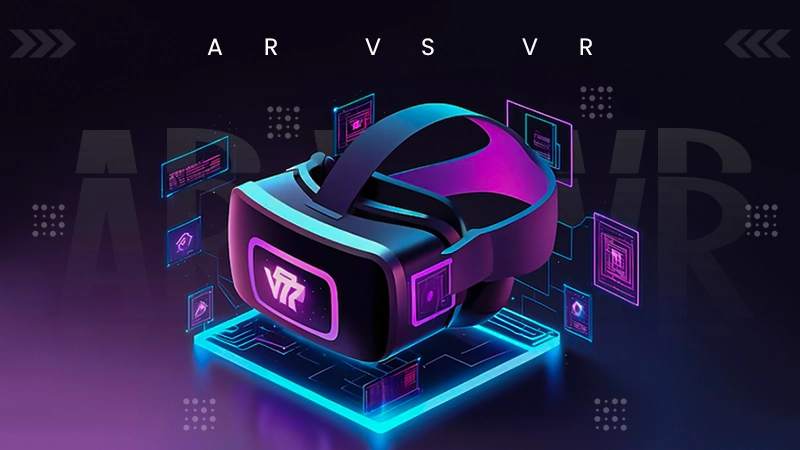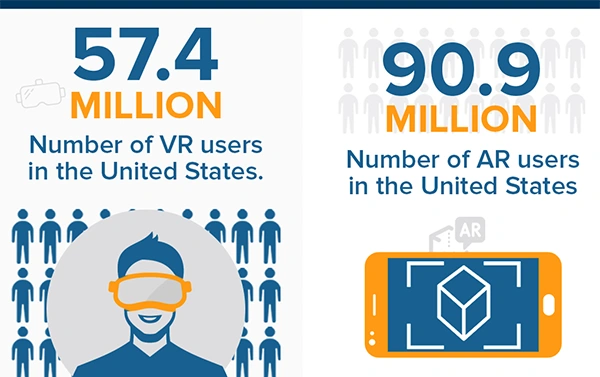
Augmented Reality (AR) and Virtual Reality (VR) – Both these technologies are growing at a rapid pace.
They are not just sharing the common goal of providing users with simulated experiences, combining the virtual and the real world, but also changing the way we use screens.
These technical models are transforming how businesses interact with customers, train employees, and deliver immersive experiences.
However, while AR and VR share similarities, they are distinct technologies with unique applications and benefits.
That’s why it’s important to understand the differences between these two – AR and VR so that businesses can determine which technology is best suited to their needs and preferences.
To know, go through this blog!!
Augmented Reality (AR) is a technology that overlays digital elements onto the real world, enhancing what users see, hear, and experience in their physical environment.
Unlike VR, which creates a completely immersive virtual environment, AR allows users to interact with the real world while simultaneously experiencing digital enhancements.
AR is widely used in industries such as retail, real estate, and education, for example, in retail, customers can use AR to visualise how furniture will look in their home before purchasing it.
In real estate, potential buyers can take virtual tours of properties while still seeing their real surroundings.
In education, AR can bring textbooks to life by overlaying interactive elements on top of traditional learning materials.
One of the main advantages of AR is its ability to enhance customer engagement by providing interactive and personalised experiences.
It is also relatively easy to use, as many AR applications can be accessed via smartphones and tablets, making it highly accessible to a wide audience.
Businesses looking to improve customer interaction and offer innovative experiences should consider working with an Augmented Reality agency to integrate AR into their strategies.
Do You Know?
The first VR / AR head-mounted display was created by Ivan Sutherland and his student Bob Sproull in 1968, and that was connected to a computer and not a camera.
Virtual Reality (VR), on the other hand, creates a fully immersive digital environment that completely replaces the user’s physical surroundings.
Through the use of headsets and controllers, users can explore and interact with a 3D virtual world, offering a level of immersion that AR does not provide.
VR is particularly popular in industries such as gaming, training, and tourism; in the gaming industry, VR allows players to fully immerse themselves in a game world.
In training, VR can simulate real-life scenarios, enabling employees to practise skills in a safe and controlled environment.
In tourism, VR offers virtual tours of destinations, allowing potential travellers to experience a location before booking a trip.
The primary advantage of VR is its ability to create detailed simulations and immersive experiences that can be used for entertainment, education, and training.
However, VR requires more specialised hardware, such as headsets and motion controllers, which can be more expensive and less accessible than AR.
While both AR and VR offer unique benefits, they differ significantly in terms of immersion, hardware requirements, and user experience.
VR offers a higher level of immersion, creating a completely virtual environment, whereas AR enhances the real world with digital elements.
AR is generally more accessible, requiring only a smartphone or tablet, while VR typically requires more advanced hardware.
In terms of content creation, developing VR experiences can be more complex and costly due to the need for fully rendered 3D environments.
In contrast, AR content can often be created and integrated more easily, making it a more cost-effective option for many businesses.

AR is ideal for businesses in retail, marketing, and field services where enhancing customer engagement and providing real-time product previews are important.
It is also a cost-effective option for businesses looking to integrate technology without significant investment in hardware.
VR is best suited for industries like training, entertainment, and real estate, where immersive experiences and detailed simulations are key.
If your business goals involve creating a fully immersive environment, VR may be the right choice.
In some cases, combining AR and VR can offer the best results for example, a business might use AR for customer engagement while utilising VR for employee training.
By leveraging both technologies, businesses can create comprehensive solutions that address multiple needs.
Both AR and VR offer unique opportunities for businesses to innovate and engage with their customers.
The choice between AR and VR depends on your specific goals, industry, and budget.
By carefully considering these factors, you can determine which technology is best suited for your business.
If you’re ready to explore the possibilities of AR and VR, partnering with an experienced augmented reality agency can help you navigate this exciting technological landscape and make the most of these powerful tools.
Subscribe to our newsletter and get top Tech, Gaming & Streaming latest news, updates and amazing offers delivered directly in your inbox.